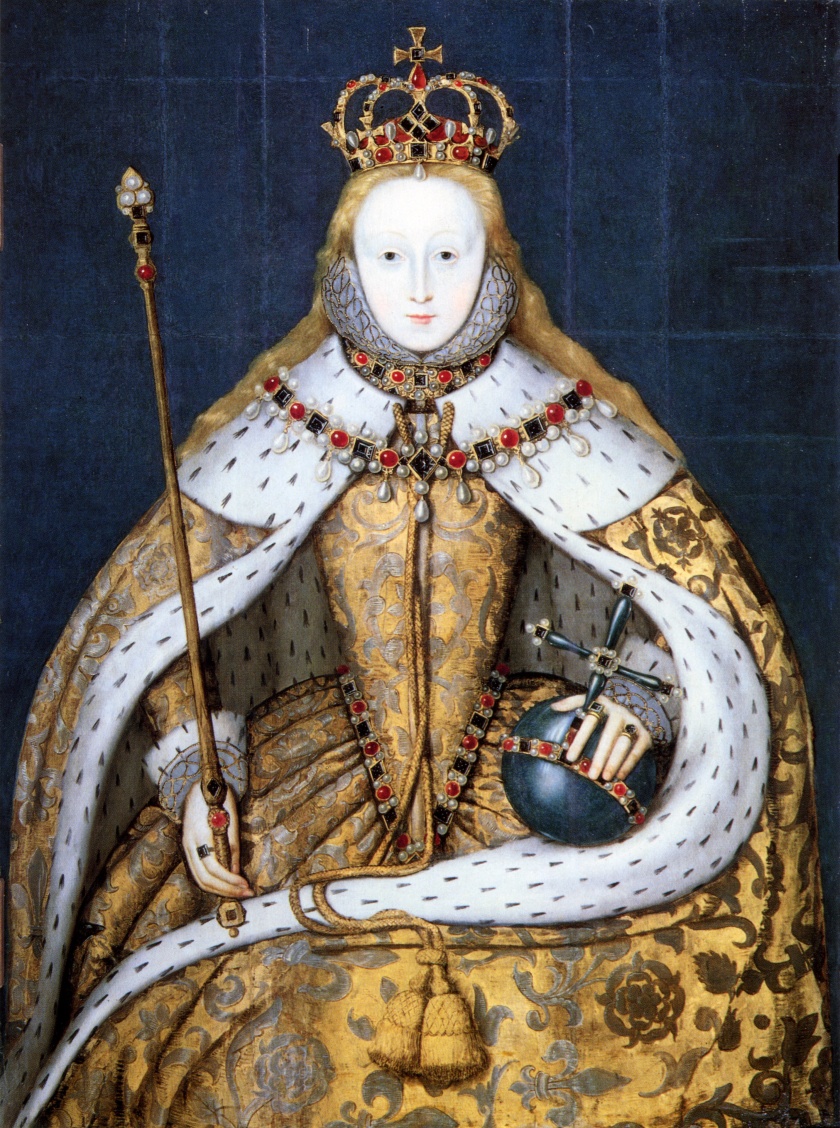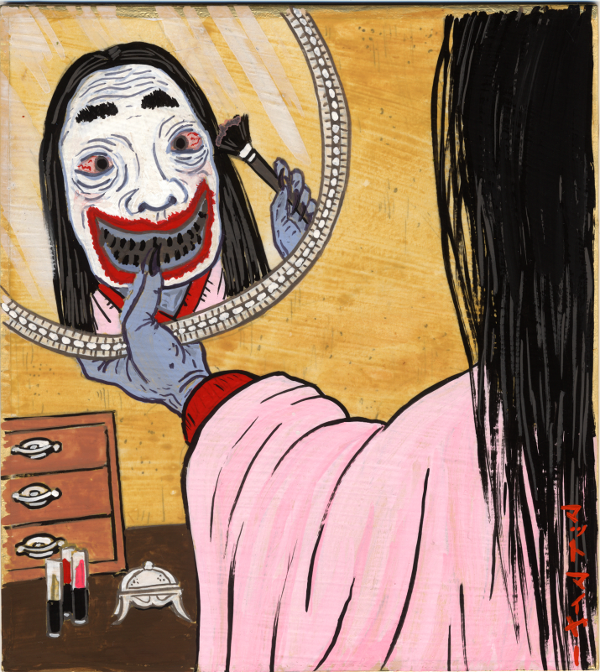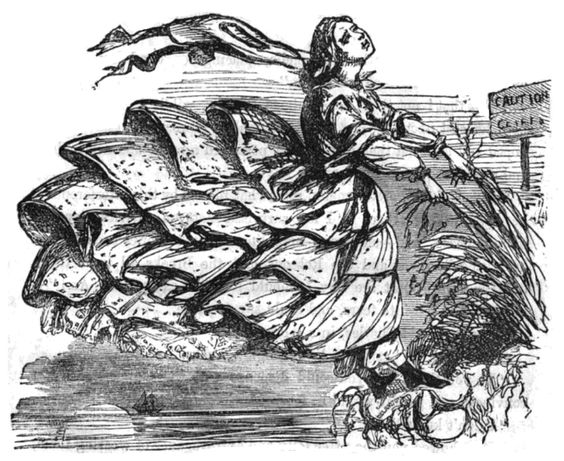First published in Fortean Times no. 345
Throughout history, people have tried to distinguish themselves from the common herd by turning to fashion and cosmetics, even when the results could be bizarre, harmful and even fatal, giving the expression “fashion victim” a literal meaning. Maria J. Pérez Cuervo tightens her stays and reports from the runway.
A killer complexion
Smooth, youthful skin has been an ideal of beauty for millennia, due to its associations with health and fertility. In Ancient Greece, men favoured a tanned skin, the consequence of exercising in the gymnasion. However, since women who worked outdoors would also have been naturally tanned, pallor was considered patrimony of female aristocracy, and therefore a desirable trait. To fake an alabaster complexion, women resorted, in the words of Greek poet and physician Nicander of Colophon (2nd century BCE), to a “hateful brew compounded with gleaming, deadly white lead, whose fresh colour is like milk which foams all over”. Lead was identified with Cronus or Saturn and could cause acute poisoning, known as saturnism. Nicander described most of its symptoms, such as hallucinations and paralysis, and recommended purgative treatments. But critical voices didn’t dim its popularity: lead provided an opaque foundation, not dissimilar to a coat of plaster, a canvas over which soot could be used as eyeliner and crushed berries or flower petals as blusher.
Most contemporary sources equate the use of cosmetics with the “deceitful” nature of women, which shows that things haven’t changed much over the centuries. The older woman who uses cosmetics to attract a younger lover became a comedic trope, and in Xenophon’s Socratic dialogue Oeconomicus, Ischomachus admonishes his wife, arguing that her pallor should be a “natural” consequence of her containment within the oikos, not something achieved through artificial means.
The Romans also favoured lead, but their rouge of choice, cinnabar, or mercury sulfide, was less innocuous than a few crushed flower petals. The fact that it was mined by slaves and convicts indicates that its hazardous effects (mercurialism, a disease that can cause tremors, madness and death) were widely known at the time. Again, this didn’t stop the Romans from using it everywhere: not only on the skin, but also in architecture and statues. Mining mercury was a slow death sentence, but one that proved profitable for the Empire.
Lead continued to be used throughout the Middle Ages, an era in which a blemish, a mole or a birthmark could be considered solid evidence of witchcraft (the so-called “witches’ marks”, supposedly made by the Devil himself), with all the dire consequences such an accusation entailed. But perhaps poisonous make-up reached the height of its popularity in the Renaissance, where a “virginal” white was synonymous with beauty. Venetian Ceruse — or its more poetic denomination, “the Spirits of Saturn”– became the most sought-after cosmetic. In A tracte containing the Artes of Curious Paintinge, Carvinge and Building, Giovanni Lomazzo explains that it is “made of lead and vinegar; which mixture is naturally a great drier”. It was not only used by women to improve their complexions, but also “by chirurgions to drie up moiste sores”. Women who used it, according to him, “quickly become withered and gray headed, because this dowth so mightely drie up the naturall moysture of their flesh”.

Ceruse was also popular, both among men and women, in Elizabethan England. Contemporary portraits of the Queen show her as the ideal of beauty, with her golden red hair, high forehead and marble skin. In an era where pox was frequent, unblemished skin was a nigh-unattainable ideal. But of course, we’re all the same in illness and death: the Queen famously suffered a bout of smallpox in 1562, when she was 29. It left her skin scarred [1]. After her illness, she resorted to applying thicker layers of make-up. The fate of her royal skin wasn’t dissimilar to that of the commoners: lead and mercury lotions caused the skin to react; breakouts and impurities were covered by increasingly thicker layers, often without washing the previous layer off, and eventually the skin was corroded by the chemicals at work. This is why wearing skin patches became fashionable, as evidenced by a peddler rhyme from 1640 that offers “patches (…) of ev-ry cut for pimples and for scarrs”.
Despite health hazards, the use of lead in beauty products continued well into the 19th century. The Countess of Coventry, a society beauty who died of lead poisoning in 1760 aged 27, was branded “a victim of cosmetics”. In 1869, several cases of lead palsy from the use of cosmetics were studied by the American Medical Association. At the same time, arsenic-based cosmetics were advertised everywhere, and even now, according to a report from the WHO, mercury is still used in skin lightening products.
Hair like a rat’s nest
Thick, lush hair is indicative of youth, health and fertility. Because of its aesthetic value and its social role, hair was a valuable possession, and often the object of criminal acts. The popularity of wigs in Europe from the 16th century caused the flourishing of a profitable hair market, but also the rise of muggers who targeted women and children. In the 19th century, hair was worth twice its weight in silver, and 1869 saw outbreaks of hair theft in both New York and London. A letter to The Times warned readers that “a young friend of ours has just had the whole of her hair cut off in broad daylight in Westbourne Grove.”
Arguably, although the 1980s were a strong contender, peak big hair occurred in the 18th century. When Queen Marie Antoinette wore her hair in a pouf at the coronation of her husband Louis XVI in 1775, she started a trend that would define the period. Her own mother, Maria Theresa of Austria, lectured her on what was hair-appropriate in a letter written in the same year: “[The papers] say that from the roots it measures 36 pouces high and with all the feathers and ribbons that hold all of that up! You know that I have always been of the opinion that one should follow fashion moderately, but never carry it to excess. A pretty young queen full of charms has no need of all these follies.”
Marie Antoinette clearly didn’t think so. Although a fashion icon of the time, she hadn’t been the first one to sport this hairstyle: the previous year, the Duchess of Chartress had appeared at the opera with a monumental creation by hairdresser Leonard Autie, including decorations and ornaments such as ships, ostrich feathers and miniature animals.
The taller the hair, the more fashionable the wearer, but such trends required a thorough dedication and industrial quantities of styling pomade. Usual ingredients were beef marrow, bear grease, mutton fat or pig lard, the latter being the most expensive since it had a “milder” odour. Essential oils, such as hazelnut oil, lemon and clove oil were added to disguise the stench, doubling up as flea, moth and tick repellents. The hair was then covered with a special powder containing corn, wheat flour, or milled and sieved starch, sometimes dyed blue, pink or lilac.
The coiffure was so elaborate that it couldn’t be redone easily, and for this reason it was washed as little as possible. Women slept over several pillows, wearing special nightcaps to protect it from mice and rats. These caps couldn’t have stopped other vermin, hence the widespread use of silver claws, often laid out with the silverware for guests to idly scratch their heads at dinner parties.
A deadly stare
Eye make-up has also been used since Antiquity. The Egyptians used galena mesdemet and khol, striking green and black pigments containing toxic lead and malachite (copper). Green was the colour of the eye of Horus, a protective amulet also known as Wadjet, derived from the word “wadj”, or green. The practice was thought to ward off evil spirits, and women even regularly painted the eyes of infants. Despite the toxicity of these substances, recent studies establish that some of the components reacted against bacteria present in tropical marshy areas, thus effectively protecting the wearer from infections. Eye make-up was so important that it appears in the Book of the Dead: “Before presenting himself at the Hall of Justice, the deceased must purify himself, dress in white garments, make up his eyes and anoint himself. Only then may he enter the realm of Osiris.”
In the Renaissance, deadly nightshade acquired the more poetic name belladona (beautiful woman) because it was used for cosmetic purposes: when applied to the eyes it would enlarge the pupil, creating a youthful glow and mimicking the natural effects of sexual attraction. The drug could cause visual distortion, sensitivity to light, increased heart rate and blindness. Symptoms of poisoning included confusion, hallucinations, delirium, convulsions and death.
Eyebrows have been plucked, shaved, painted and stuck on, depending on trends. Romans and Greeks favoured monobrows, which could be achieved with goat hair attached with resin. In the Heian period in Japan, the standard of beautiful eyebrows was embodied in a practice called hikimayu, where they were shaved and redrawn as cloud-like smudges. In the Elizabethan era, eyebrows and hairlines were plucked to emphasise a generous forehead. Later, in the 18th century, bold brows were back in fashion, and for those who weren’t blessed by nature, patches of mouse fur were a popular resource.
A smile as dark as night
For a culture obsessed with teeth whitening it is hard to imagine that black teeth were once fashionable. This was the case among Japanese aristocrats at least from the third century. The practice was called ohaguro, meaning “esteemed black teeth”, for which iron filings were dissolved in vinegar and mixed with vegetable tannins from tea or gallnut powder. In Travels in Europe (1795), Swedish naturalist Carl Peter Thunberg describes the method: “Ohaguro (…) is prepared from urine, filings of iron, and sakki: it is fœtid and corrosive. It eats so deeply into the teeth, that it takes several days and much trouble to scrape and wash it away. It is so corrosive, that the gums and lips must be well covered while it is laid on, or it will turn them quite blue.” In early periods the custom was restricted to the men, women and children of the court, but it was later only applied to the samurai class and to married women, perhaps as a symbol of fidelity. Lacquered black teeth can still be seen in geisha quarters, but also among some women in remote areas of Vietnam, where white teeth were the mark of savages, wild animals and demons.

Aonyobu (blue wife, the ruined aristocrat) by Matthew Meyer
In Elizabethan England, black teeth were also an object of desire, although for very different reasons. Sugar was an import, only affordable to the rich. Its consumption caused the upper classes to sport rotting teeth, which became a status symbol. However bizarre we may judge them now, black teeth weren’t necessarily a health hazard, but the consequences of a poor dental hygiene could have well been. From the 18th century, those surgeons who began experimenting with implants did so by using the teeth of dead people, which were cheaper than those sold by the living. As quoted by Ruth Richardson in Death, dissection and the destitute, a professor of Anatomy at Trinity College in Dublin said in 1831: “Very many of the upper ranks carry in their mouth teeth which have been buried in the hospital fields”. Some of them could end up suffering the same fate of the teeth’s previous owner, since illnesses such as syphilis or tuberculosis were unknowingly transmitted in such procedures.
Death by corset
Although in the popular imagination corsets might be regarded as a product of 19th century fashion, they had already appeared in ancient Crete. Tight lacing had a reputation for causing health problems, something which is illustrated in one of the first versions of Snow White: the poisoned apple wasn’t the Wicked Stepmother’s first choice for murder, but a final resort after a poisoned comb and asphyxiating bodice lace failed. The message is clear: young girls, you’ll be punished for your vanity.
Dizziness and fainting were frequent problems among corset users, since the pressure restricted the blood flow. Technically, tight corsets could fracture a rib, which might then puncture a lung. Brisk movements could also affect vital organs such as the spleen or the liver, and in the past, this could have been fatal. They could also cause miscarriages when worn during pregnancy (they were, in fact, used to conceal unwanted pregnancies), by inhibiting the expansion of the uterus.
However, Victorian physicians blamed corsets for a long series of ailments, such as gallstones, prolapses and the hazy and ubiquitous hysteria. They were also thought to be responsible for weakened pelvic muscles and the delivery of children that were either crippled or developed low intelligence. But, as Valerie Steele suggests in The Corset: a cultural history, corsets were associated with sex, so these reactions would have been a way of perpetuating the image of women as maternal figures, domestic angels restricted to the family sphere, instead of more “mundane” human beings with earthly inclinations.

Even though in popular culture they’re linked to frivolous young women, corsets were also worn by men, particularly by dandies in the late 18th and early 19th centuries. In 1821 King George IV almost fainted due to the constriction of his corset. In 1912, stage actor Joseph Hennella, a female impersonator, collapsed on stage and died three hours later. He was wearing a “corset tightly laced” that he used to conceal his “increasing girth”. Hospital physicians concluded that the corset “caused a kidney trouble and induced a tendency to apoplexy”.
Deadly shades
The most expensive pigments have always produced the most desirable colours, allowing the wearer to stand out from the masses, who wore muted, natural colours. Purple is the emblem of royalty because Tyrian purple, obtained from certain snails, was the most expensive pigment, and although there was nothing deadly in this substance, other pigments, such as the already mentioned cinnabar, were certainly hazardous.
Before Carl Wilhelm Scheele developed a new method in the Georgian era, green was achieved by overlaying blue and yellow. By mixing arsenic and copper, Scheele produced a bright emerald green, highly toxic but remarkably intense both under gaslight and natural light, which may explain its popularity. In England, the new hue was used in clothes, glass, soaps, lampshades, wallpapers, children’s toys, candles, confectionary and even artificial flowers. Mauve, the new hue created by William Henry Perkin in 1856, also enjoyed the same popularity. Sadly, arsenic and picric acid were among its ingredients.
The ballerina holocaust
Before the arrival of electricity, gaslight and fireplaces presented many risks for the fashionable. Crinolines, used to support skirts in the 19th century and worn by women of all social classes, were highly flammable, and it is estimated that crinoline fires killed 3000 women between 1850 and the late 1870s in the UK. The garment also caused numerous bizarre accidents, dragging women into the sea or blowing them off cliffs.

The Dangers of Crinoline, 1858. Source: X
The fatal combination of gas lamps and highly flammable muslin skirts was responsible for the tragic deaths of several young Victorian ballerinas. The papers in March 1845 mention the “Shocking death of miss Clara Webster”. While the ballerina was performing in Revolt of the Harem, splashing water on the other slave-girls, her muslin dress brushed against a gas lamp and caught fire. The horrified audience, among which was her mother, watched her burn. A carpenter at the side wing intervened, throwing her on the ground and extinguishing the fire. Despite his heroic efforts, Webster died two days later. The coroner advised the use of a solution of muriate of ammonia over the muslin and a network of wire over the lamps to prevent other accidents.
There were others after Clara Webster. The solution of ammonia made the muslin stiff and uncomfortable to wear, giving it a yellowish, not very attractive, tinge. Emma Livry, the star of the Paris Opera Ballet, died in 1863, but also Julia McEwen, Fanny Smith, and others from Marseilles, New York, Liverpool and Naples.
The horror, the horror
The list of fashion-related deaths and injuries is never-ending: the so-called lotus feet caused by foot binding; hatters afflicted by mercurialism; collars that induced apoplexy; terrifying tapeworm diets; crocodile excrement baths and face masks; powdered human skull concoctions to promote vigour; leeches to induce pallor; urine baths for supple skin; radioactive cosmetics to “activate circulation”.
We may laugh at the excesses of our forebears just as we shake our heads and tut when we see the latest celebrity deformed by cosmetic surgery or numbed by injections of botulinum toxin. Perhaps we should pity our human condition instead, and admit that this will continue for as long as we are humans. Isn’t fashion, after all, a clumsy way of asserting our unique identity, an attempt to outrun eternal oblivion?
NOTES
[1] According to popular belief, lead poisoning also made Queen Elizabeth bald, even though there are sources that remark that she still had hair in her later years. Hair loss is indeed a result of lead poisoning, though it only appears in advanced stages.
SELECTED BIBLIOGRAPHY
Richardson, Ruth: “Death, dissection and the destitute: The politics of the corpse in pre-Victorian Britain” (2001)
Smith, Christine A.: “So Tasteful: A Note About Iron-Gall Ink” (2003)
Steele, Valerie: “The Corset: a cultural history” (2001)
Thuberg, Carl Peter: “Travels in Europe” (1795)
Xenophon: “Oeconomicus” (c. 362 BCE)

You must be logged in to post a comment.